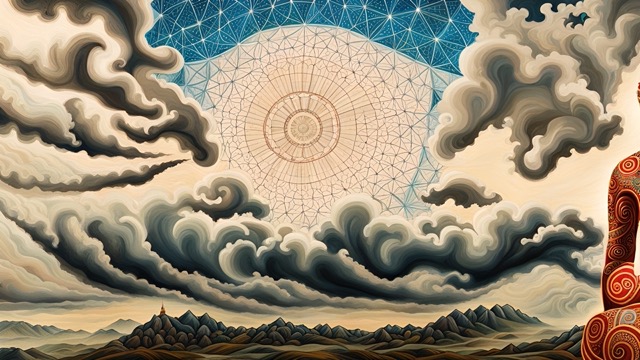Nestled at the epicenter of a captivating discourse that bridges the realms of spirituality and artistic expression, the intricate interplay between psychedelic arts and the foundational teachings of Buddhism unfurls like a tapestry of insight and intrigue. At its very nucleus, the essence of early Buddhist wisdom revolves around the profound recognition of impermanence — a foundational principle that illuminates the ephemeral and ever-evolving nature inherent in all facets of existence. This age-old tenet, akin to a steady compass guiding seekers through the labyrinth of reality, finds a mesmerizing echo within the contours of psychedelic artistry. As observers become entranced by the kaleidoscopic visuals and intricate patterns that adorn the canvas, they are swept into a journey of perception where shapes and forms shift and morph with every contemplative gaze. This dynamic interplay between the observer and the observed mirrors the ceaseless ebb and flow of existence itself, serving as an artistic testament to the ceaseless flux that characterizes life's journey.
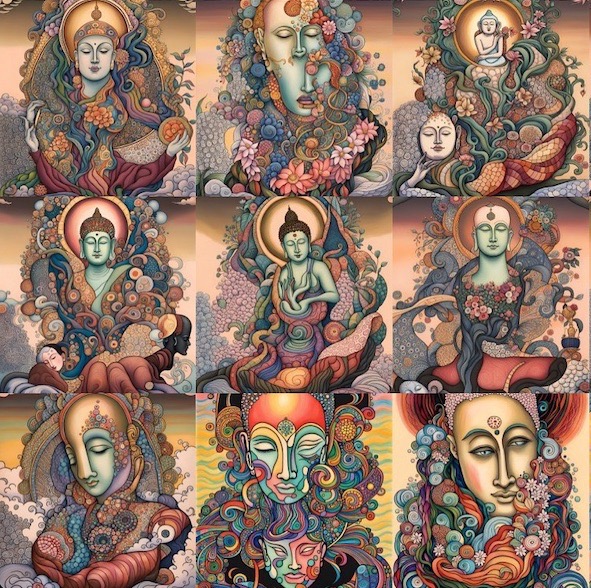
Venturing further into this captivating terrain, we find ourselves drawn to the heart of this exploration — a realm where the resonances between early Buddhist doctrines and the vibrant strokes of psychedelic artistry are not only evident but profound. Central to the early teachings of Buddhism is an unwavering emphasis on the transient nature of all phenomena and the illusory constructs of the self. These teachings beckon individuals to peer beyond the veil of conventional understanding and embrace the profound insight that the self is a construct, a mere illusion that crumbles upon closer scrutiny. In this kaleidoscopic dance of philosophical thought, psychedelic art steps onto the stage as a unique and vivid messenger, a gateway through which the profundities of these ancient teachings find new and resounding voice. With its vibrant hues that seem to leap from the canvas and surreal forms that defy traditional dimensions, psychedelic art mirrors the very essence of these teachings.
Psychedelic Arts
Psychedelic art is a genre of visual expression that emerged primarily during the 1960s and is closely associated with the psychedelic culture of that era. It is characterized by its vivid and vibrant colors, intricate patterns, and surreal imagery. The art often seeks to capture and convey the altered states of consciousness and expanded perceptions that are often associated with psychedelic experiences induced by substances like LSD, psilocybin, and mescaline. Here are some key characteristics of psychedelic art:
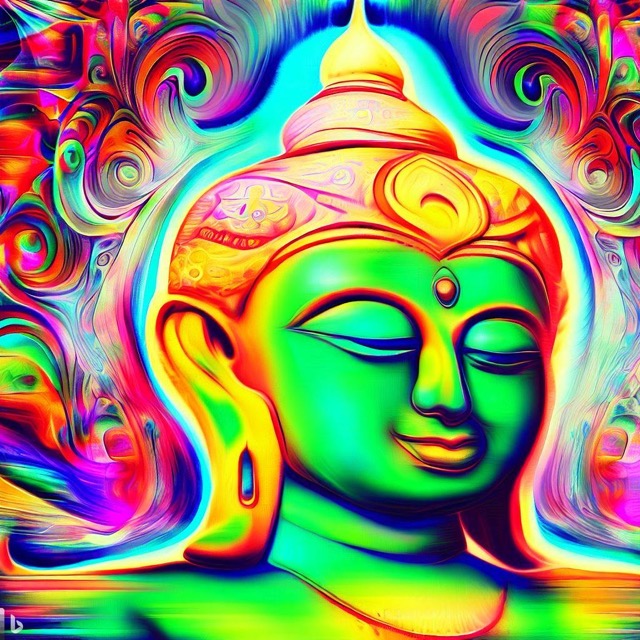
-
Vivid Colors: Psychedelic art is renowned for its bold and intense color palettes. Electric blues, vibrant pinks, neon greens, and intense purples are frequently used to create visually striking and emotionally resonant compositions.
-
Surreal Imagery: The art often employs surreal and fantastical imagery that transcends the boundaries of conventional reality. This can include distorted or morphing shapes, impossible architectures, and dreamlike landscapes that evoke altered states of consciousness.
-
Intricate Patterns: Intricate and highly detailed patterns are a hallmark of psychedelic art. These patterns can be mesmerizing and may appear to be moving, pulsating, or flowing, creating a sense of movement and dynamic energy within the artwork.
-
Optical Illusions: Many psychedelic artworks incorporate optical illusions, creating visual effects that can be mesmerizing to the viewer. These illusions can distort perceptions of depth, movement, and proportion.
-
Fluidity and Movement: Psychedelic art often gives the impression of movement and fluidity, as if the forms are shifting, undulating, or flowing. This can evoke the sensation of being in a state of constant transformation.
-
Mystical and Spiritual Themes: Many psychedelic artworks explore themes of spirituality, mysticism, and altered states of consciousness. These themes are often intertwined with a sense of interconnectedness and unity with the universe.
-
Nonlinear Composition: Traditional rules of composition and perspective may be disregarded in favor of creating a more dynamic and abstract visual experience. This can result in unconventional and captivating compositions.
-
Repetition and Mirroring: Symmetry, repetition, and mirroring are commonly used techniques in psychedelic art. These techniques can enhance the visual impact of the artwork and create a sense of rhythm and harmony.
-
Psychedelic Iconography: Certain symbols and motifs are frequently found in psychedelic art, such as fractals, mandalas, spirals, and cosmic imagery. These symbols can hold deep personal and universal significance.
-
Expressive and Emotional: Psychedelic art often seeks to evoke emotional responses and convey a sense of wonder, awe, and introspection. The art can communicate the ineffable aspects of psychedelic experiences that are difficult to put into words.
Overall, psychedelic art is a visual exploration of the inner landscapes of consciousness, capturing the essence of altered states of mind and inviting viewers to delve into realms that transcend the ordinary perceptions of reality.
Breaking the Chain of Illusion
Psychedelic art can be a tool for the exploration of consciousness, mirroring the transformative journey of Buddhist practitioners. Through intricate designs and surreal imagery, these artworks draw us into a realm where the mundane gives way to the mystical. As we engage with psychedelic art, we are invited to shift our perspective, much like the shift in perception advocated by early Buddhist teachings. Here, the ego's dominance is challenged as patterns shift, colors blend, and forms dissolve. Similarly, early Buddhist teachings encourage us to transcend the ego's grip on our identity. By doing so, we embrace a state of interconnectedness that mirrors the psychedelic experience. The illusion of a separate self begins to crumble, replaced by a sense of unity with all beings.
Impermanence: Dissolving Patterns
As we gaze upon these ever-changing visuals, we're reminded that nothing remains static. The art reflects the Buddhist practice of observing impermanence, prompting us to question attachments to transient forms.
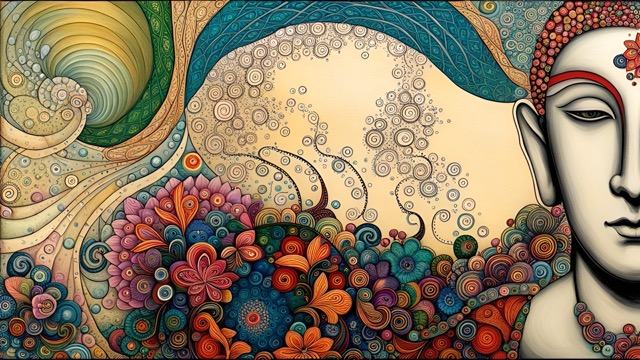
Non-Self: Disintegration of Boundaries
The transformative effects of psychedelic arts dissolve the boundaries and patterns that have been long formed. The artworks do not fall into a logical form of what should be and should not be. Rather, it invites one to recognize that all forms are made from the mind and conditioned by one's upbringing and that the nature is interconnected. Just as one's mind can become entangled in desires and attachments (see here: Exploring Desires through Art), viewers can become entranced by the complexities of the artwork.
Further more, the Buddhist concept of Dukkha, commonly translated as suffering is mirrored in psychedelic arts where one can be exposed to their inner anxieties and fears. Buddhist teachings encourages the examination of suffering and its root causes which is in line with psychedelic experiences. The chaos of the unenlightened mind (delusion) against the serene clarity of an awakened consciousness is clearly depicted in psychedelic arts.
Duality
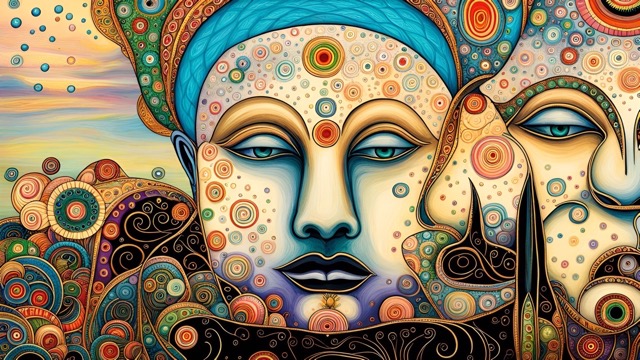
Psychedelic art dances with dualities, showcasing the co-existence of vibrant colors and intricate patterns with unsettling and chaotic elements. This juxtaposition reflects the balance sought in Buddhist philosophy—a harmony between acceptance of suffering and the pursuit of liberation. The heightened state of consciousness induced by psychedelics can offer a unique opportunity to cultivate mindfulness. Psychedelic art can encourage viewers to engage with the present moment fully, as they observe the artwork's intricate details and shifting patterns.
Buddhist psychedelic art stands at the crossroads of ancient wisdom and contemporary creativity. By harnessing the power of vivid visuals, these artworks invite viewers to explore the depths of the human experience, echoing the teachings of impermanence, suffering, and the path to enlightenment found in early Buddhist philosophy. As we gaze upon the intricate tapestries of color and form, we are reminded of the profound connection between art, spirituality, and the quest for understanding.
